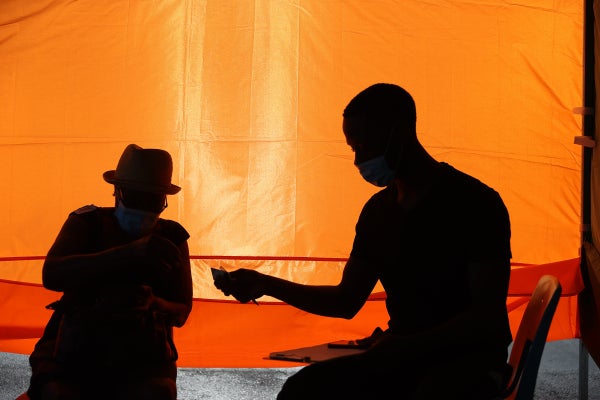Editor’s Note (12/21/21): This article is being showcased in a special collection about equity in health care that was made possible by the support of Takeda Pharmaceuticals. The article was published independently and without sponsorship.
Grassroots organizers in Boston, primary care innovators in Chicago and even an academic medical center in Philadelphia responded to the COVID pandemic by bringing mobile vaccine clinics directly to the neighborhoods most impacted by the virus. As a result, 85 percent of those vaccinated by Philadelphia’s effort were Black, while 81 percent of those vaccinated by Boston’s effort identified as persons of color. COVID mobile vaccine clinics work.
As the number of COVID cases falls in the United States, the frameworks used by mobile vaccine clinics should not be abandoned. Instead, these frameworks should be adopted and applied to health conditions that disproportionately impact communities of color. They provide health care delivery one path forward to achieving health equity.
One framework includes our own. Part of our team operates GOTVax, a grassroots organization in Boston that assembles providers, students, electoral campaign staff and community organizations to upstand mobile vaccine clinics in communities of color. Our efforts leverage trusted community partners and get-out-the-vote tactics: wide-scale text messaging, phone banking, and door-knocking. So far, we have delivered over 6,000 vaccines to communities of color.
What would this framework look like with a health condition like hypertension, where 11 million people are undiagnosed and the burden of disease is disproportionately placed on patients of color?
First, the effort must include a wide-scale education campaign. Black people make up 13 percent of the U.S. population, but only about 5 percent of physicians are Black. This places many disadvantaged communities without trusted messengers in their vicinity to address health information deficits. This was especially a challenge with the COVID vaccines.
When the vaccines were first introduced in December,
studies demonstrated that racial/ethnic concordance led Black patients to seek more information about the vaccine. However, historical instances of systemic racism, such as the Flexner Report, led to a paucity of Black physicians and left many Black community members without reliable resources to find information about the vaccine. Therefore, one of us created We Got Us, a nonprofit organization that connects Black community members and organizations with trusted Black health care personnel.
We Got Us holds empowerment sessions that engage community members in conversations about medical racism in Black communities, the vaccine development process, and specifics about the COVID-19 vaccines. Together, we increase access to the vaccine through a two-pronged approach by addressing both the informational and physical barriers to getting vaccinated.
Doing this work for hypertension could mean that discussions revolve around medical racism in communities of color, the drug development process for common hypertensive drugs, and specifics about the disease. Research shows that individuals with higher general trust in the medical system are more likely to report better adherence to hypertensive medications. Further, the signs and symptoms of hypertension are often misunderstood. Deploying community-specific education programs will be critical to ensuring health equity.
Second, the effort should deploy a tactical canvassing approach to ensure that identified community members are being targeted for education and clinic day purposes. At GOTVax, we conduct three rounds of outreach: text messaging, phone banking and door-canvassing. To reach community members untouched by our health care system—typically Black and Latinx folks—we work with public housing managers, unions and community-based organizations. Through them and our on-the-ground door knocking volunteers, we are able to develop outreach lists that are used to sign people up for the COVID-19 vaccine.
Operationalizing this strategy for hypertension would be similar to our approach. Outreach workers would text, call and have face-to-face conversations with individuals. If the recipient has not been screened for hypertension, they would be made aware of an upcoming hypertension clinic. If the recipient has hypertension but adds that their condition has not been consistently managed, they would also be invited to the clinic. Those with a diagnosis and adequate treatment would require no further follow-up.
Similar to the GOTVax approach, this outreach operation should include multilingual, multiracial and multiethnic workers. Research shows that Black people are more likely to receive preventive services when seeing a Black doctor, as opposed to a non-Black doctor. The same is likely true for other communities of color.
The final piece of the framework includes hypertargeted clinics. After education and outreach, we set up clinics in communities with poor access to vaccination centers. Hypertension clinics could take place in gymnasiums, churches, public housing units and other community spaces within disadvantaged communities. They could also be aided by local community health vans that already operate within these neighborhoods, such as the Family Van in Massachusetts.
Individuals would be signed up for an appointment during outreach and the appointment could include hypertension screening, medication reconciliation, signing up eligible patients for health insurance, and connecting patients with a primary care provider.
Transitioning from a vaccine-focused campaign to campaigns focused on other health conditions will require input from various stakeholders, from those we work with (electoral campaign staff, community organizations, etc.) to new partners such as physician subspecialists. They will also need to be well-resourced and should consider partnering with a community health center or academic medical center committed to communities of color.
There will likely be much iteration of these efforts, given their infancy and novelty. We at GOTVax and We Got Us have learned from our experience and applied lessons appropriately. As a result, we have noticed the impact that intentional, hypertargeted mobile clinics and health education have on the populations most impacted by COVID. Upstanding clinics for other medical conditions will likely have a similar impact and bring us one step closer to the health equity we deserve.
